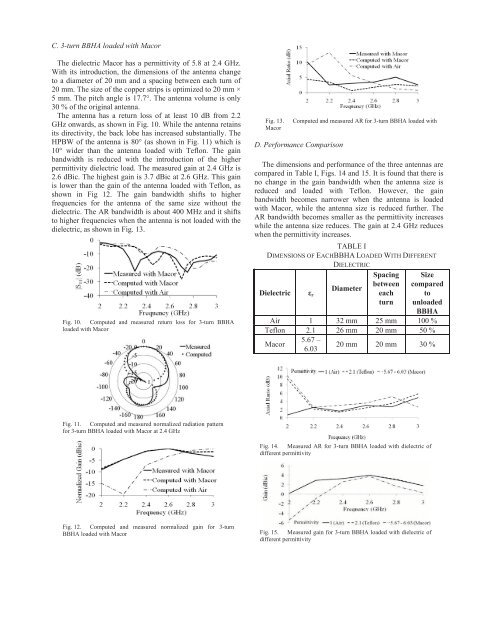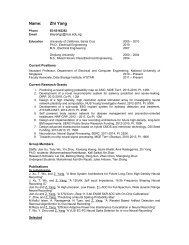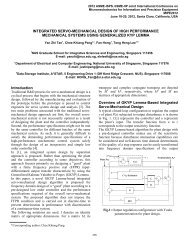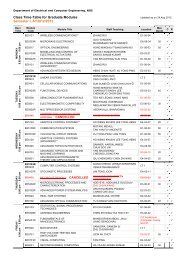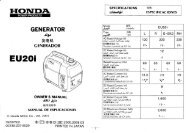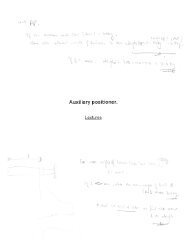Design of a Small Size Dielectric Loaded Helical Antenna for ...
Design of a Small Size Dielectric Loaded Helical Antenna for ...
Design of a Small Size Dielectric Loaded Helical Antenna for ...
Create successful ePaper yourself
Turn your PDF publications into a flip-book with our unique Google optimized e-Paper software.
C. 3-turn BBHA loaded with Macor<br />
The dielectric Macor has a permittivity <strong>of</strong> 5.8 at 2.4 GHz.<br />
With its introduction, the dimensions <strong>of</strong> the antenna change<br />
to a diameter <strong>of</strong> 20 mm and a spacing between each turn <strong>of</strong><br />
20 mm. The size <strong>of</strong> the copper strips is optimized to 20 mm ×<br />
5 mm. The pitch angle is 17.7°. The antenna volume is only<br />
30 % <strong>of</strong> the original antenna.<br />
The antenna has a return loss <strong>of</strong> at least 10 dB from 2.2<br />
GHz onwards, as shown in Fig. 10. While the antenna retains<br />
its directivity, the back lobe has increased substantially. The<br />
HPBW <strong>of</strong> the antenna is 80° (as shown in Fig. 11) which is<br />
10° wider than the antenna loaded with Teflon. The gain<br />
bandwidth is reduced with the introduction <strong>of</strong> the higher<br />
permittivity dielectric load. The measured gain at 2.4 GHz is<br />
2.6 dBic. The highest gain is 3.7 dBic at 2.6 GHz. This gain<br />
is lower than the gain <strong>of</strong> the antenna loaded with Teflon, as<br />
shown in Fig 12. The gain bandwidth shifts to higher<br />
frequencies <strong>for</strong> the antenna <strong>of</strong> the same size without the<br />
dielectric. The AR bandwidth is about 400 MHz and it shifts<br />
to higher frequencies when the antenna is not loaded with the<br />
dielectric, as shown in Fig. 13.<br />
Fig. 10. Computed and measured return loss <strong>for</strong> 3-turn BBHA<br />
loaded with Macor<br />
Fig. 11. Computed and measured normalized radiation pattern<br />
<strong>for</strong> 3-turn BBHA loaded with Macor at 2.4 GHz<br />
Fig. 12. Computed and measured normalized gain <strong>for</strong> 3-turn<br />
BBHA loaded with Macor<br />
50<br />
Fig. 13. Computed and measured AR <strong>for</strong> 3-turn BBHA loaded with<br />
Macor<br />
D. Per<strong>for</strong>mance Comparison<br />
The dimensions and per<strong>for</strong>mance <strong>of</strong> the three antennas are<br />
compared in Table I, Figs. 14 and 15. It is found that there is<br />
no change in the gain bandwidth when the antenna size is<br />
reduced and loaded with Teflon. However, the gain<br />
bandwidth becomes narrower when the antenna is loaded<br />
with Macor, while the antenna size is reduced further. The<br />
AR bandwidth becomes smaller as the permittivity increases<br />
while the antenna size reduces. The gain at 2.4 GHz reduces<br />
when the permittivity increases.<br />
TABLE I<br />
DIMENSIONS OF EACHBBHA LOADED WITH DIFFERENT<br />
DIELECTRIC<br />
<strong>Dielectric</strong> �r<br />
Diameter<br />
Spacing<br />
between<br />
each<br />
turn<br />
<strong>Size</strong><br />
compared<br />
to<br />
unloaded<br />
BBHA<br />
Air 1 32 mm 25 mm 100 %<br />
Teflon 2.1 26 mm 20 mm 50 %<br />
Macor<br />
5.67 –<br />
6.03<br />
20 mm 20 mm 30 %<br />
Fig. 14. Measured AR <strong>for</strong> 3-turn BBHA loaded with dielectric <strong>of</strong><br />
different permittivity<br />
Fig. 15. Measured gain <strong>for</strong> 3-turn BBHA loaded with dielectric <strong>of</strong><br />
different permittivity<br />
Authorized licensed use limited to: National University <strong>of</strong> Singapore. Downloaded on May 03,2010 at 14:47:24 UTC from IEEE Xplore. Restrictions apply.


